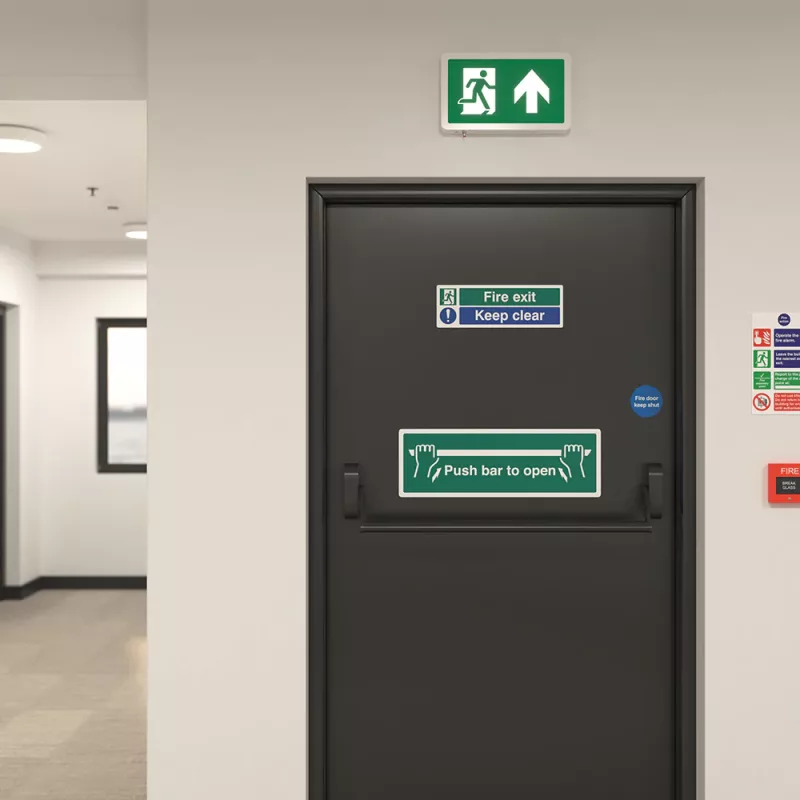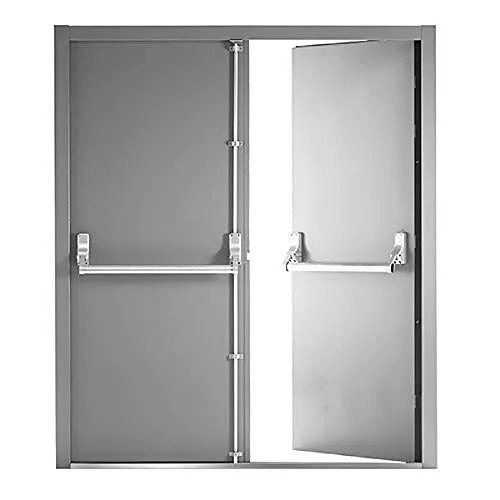
In many buildings, especially those with high foot traffic, questions often arise about what kind of doors are used in fire evacuation routes. Some refer to them as fire doors, others call them security doors, and you might even hear the term fire escape doors. At YK Door Industry Co., Ltd., a long-standing fire rated door manufacturer, we’re frequently asked to clarify the difference.
To put it simply, doors installed in fire corridors or emergency exits are generally steel fire doors that meet specific fire-resistance standards. These aren’t just any doors—they’re designed to hold back flames and smoke long enough for people to evacuate safely. While security doors serve a different purpose—focusing more on break-in resistance and structural strength—they’re sometimes confused with metal fire doors, especially in commercial settings where both safety and security matter.
Knowing the difference between fire doors and security doors isn’t just about terminology. It has real implications for safety compliance, building design, and product selection. In the sections below, we’ll explore how various doors—whether stainless steel fire doors, steel fire resistance doors, or commercial security doors—are constructed, rated, and applied in both residential and business environments.
Defining Fire Doors

At YK Door Industry Co., Ltd., a trusted fire-rated door manufacturer, we recognize the critical role that fire doors play in enhancing building safety. These doors are specifically engineered to prevent the spread of flames, smoke, and heat during a fire, acting as vital barriers within evacuation routes, stairwells, and vertical shafts. Their core function is to maintain structural integrity and delay fire propagation long enough for safe evacuation and emergency response.
Fire doors come in various classifications based on insulation performance. Commonly, they fall into three categories: fully insulated fire doors (Type A), partially insulated fire doors (Type B), and non-insulated fire doors (Type C). Each type is designed to meet specific performance needs, from thermal protection to structural resistance.
- Type A, or fully insulated doors, provide both fire resistance and thermal insulation. They are tested for resistance times ranging from 30 minutes to 3 hours—these can include metal variants like the steel fire resistance door, ideal for areas with stringent safety demands.
- Type B, partially insulated, offers insulation for up to 30 minutes, with fire resistance capabilities extending to 3 hours.
- Type C doors, often seen in industrial or mechanical spaces, prioritize structural integrity over insulation and are common in metal fire door configurations where heat insulation is secondary.
Materials matter. A standard stainless steel fire door, for instance, is often built with a steel frame, layered calcium silicate board, and filled with aluminum silicate fireproof core material. These doors aren’t just metal barriers—they’re engineered systems that ensure compliance with global standards like the British Standard (BS).
Whether installed in commercial door environments like office corridors or in industrial sites requiring metal fire doors, their strategic placement in fire zones significantly reduces the potential for property damage and saves lives.
The core material of fire doors, typically comprising a wooden framework and aluminum silicate fireproof cotton, is covered with a calcium silicate fireproof board. These doors are crucial for fire separation in buildings, often installed in firewalls, stairwell entrances, or openings for utility shafts, significantly reducing fire damage.
Distinguishing Security Doors
Security doors, formally known as “anti-theft safety doors,” can be manufactured from various materials but must pass standard tests and receive a production certificate for anti-theft products to be considered genuine security doors.
The hallmark of security doors is their robust security features, including durability and flexible operation. According to the “General Technical Conditions for Anti-theft Security Doors,” a qualified security door cannot be pried open or drilled through to create a specific size opening using standard tools within 15 minutes. Additionally, the locks used on these doors must be certified by the Ministry of Public Security’s testing center, featuring anti-drilling functions.
The new national standard categorizes security door anti-theft levels into four grades: A, B, C, and D, each offering different levels of security performance. The minimum resistance time against break-in attempts for these doors is no less than 6 minutes.
Security doors vary in material, including steel, steel-wood, stainless steel, aluminum alloy, and copper, each with unique qualities and price points. Steel-wood doors, in particular, blend with interior decor, featuring a steel core for security wrapped in decorative layers, offering the aesthetic of natural or engineered wood doors while harmonizing with interior design.
Security doors are suitable for residential buildings, high-rises, sensitive areas, and financial departments, providing an added layer of protection.
High-Performance Steel Security Doors for Commercial and Industrial Use
At YK Door Industry Co., Ltd., we engineer steel security doors with precision and performance in mind. Each unit integrates a high-grade multi-point locking system, securing up to 12 locking points around a reinforced steel frame—providing robust protection for both commercial doors and private facilities. All our models are CE certified, meeting essential compliance standards for doors used across the UK and Europe.
Customers can choose between standard and heavy-duty steel doors, differentiated mainly by the thickness of the steel plate and frame structure. We also offer double-locking steel doors, which adopt the heavy-duty framework for heightened resilience.

As a default feature, all metal security doors come with anti-jemmy studs and top-to-bottom locking points—offering enhanced resistance against forced entry. For clients seeking advanced upgrades, our accessory collection includes digital access control systems, high-security cylinders, stainless steel door closers, and fire-rated hardware components.
These stainless steel fire doors aren’t just built for security—they’re engineered for performance. Designed for commercial applications, each door can be tailored to meet acoustic and fire-protection requirements, ensuring safety and comfort without compromising design integrity.
Whether it’s for a distribution facility, office building, or residential complex, our steel fire resistance doors provide both fire protection and intrusion resistance. The door frames can be fabricated to custom dimensions, making sure every installation is a perfect fit. Once your order is confirmed, our logistics team can dispatch directly to your site or hold for warehouse pickup—ensuring prompt delivery without unnecessary delays.
While dedicated steel fire doors are available, many of our security doors offer comparable protection during emergencies, making them a cost-effective solution for high-traffic exit points and critical safety zones.
Choosing the Right Door for the Right Purpose
Different buildings call for different types of protection. Some spaces need to slow the spread of fire; others need to stand firm against break-ins. That’s where understanding the contrast between fire doors and security doors becomes important—not just in terms of structure, but in function, material, and certification.
At YK Door Industry Co., Ltd., we’ve worked with architects, contractors, and building owners across industries who rely on us for solutions that match both safety codes and practical needs. Whether you’re outfitting a warehouse with steel fire resistance doors, installing metal fire doors in a stairwell, or reinforcing access points with anti-theft security doors, we help ensure each choice fits its environment.
What sets us apart isn’t just our products—it’s our focus on making sure your fire and security needs are met with long-term reliability. If you’re looking for a dependable YK door supplier who understands real-world use and compliance, we’re here to support your next project with the right doors for the job.


Pingback: Fire safety on KSRTC buses——What can be done to improve? - YK | Fire Doors | Fire Windows | Fire Shutters